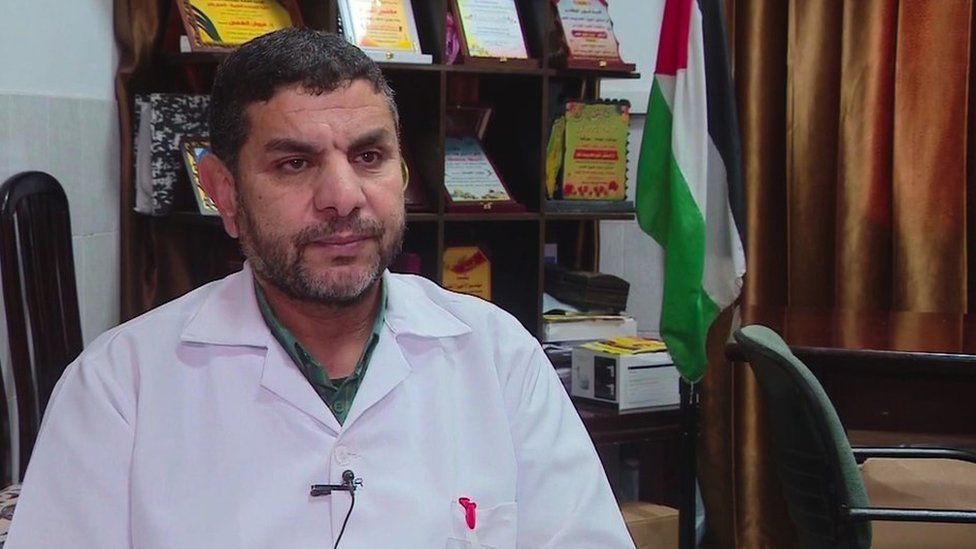“The situation in the Gaza Strip and especially in Rafah is deadly.”
Dr Marwan al-Hams is the director of Rafah’s Martyr Mohammed Yusuf al-Najjar Hospital, which has 63 beds but is currently caring for 145 patients.
The hospital is operating at more than twice its capacity because Rafah, which lies on the border with Egypt, is now home to about one million displaced Palestinians, on top of the pre-war population of 300,000.
“The lack of medicine is catastrophic and there is no space in hospitals,” Dr Hams told the BBC.
After nine weeks of war between Israel and Hamas, only 11 out of Gaza’s 36 hospitals are partially functional and able to admit new patients, according to the World Health Organization (WHO). Only one of them is in the north.
The hospitals have been overwhelmed by casualties, with the Hamas-run health ministry reporting that at least 18,600 people have been killed and 50,500 wounded.
Communicable diseases are also spreading in overcrowded shelters, schools and houses, and hospitals are receiving patients with severe diarrhoea, fatigue and a high temperature.
Such infections are spread through contaminated water and food, as well as close contact with other people.
The WHO says there is on average one shower per 700 people and one toilet per 150 people in Gaza.
People trying to survive the Israeli bombardment. It is almost impossible for them to find soap or detergent, and everything else is secondary.

“The number of people coming to hospitals and health centres with chickenpox was around 4,593… five days ago,” said Dr Hams.
Measles is also an issue, with five cases so far recorded.
Dr Hams said meningitis was another serious disease and that 115 cases had been recorded across the Gaza Strip.
Skin diseases and rashes have also been spreading, with 35,300 cases at the territory’s hospitals last Friday.
“We’ve also seen 17,511 cases of people coming to hospitals and clinics with parasites,” he said. “We can’t find the medication for them.”
In addition, there have been 19,350 cases of scabies – an itchy rash caused by tiny mites that burrow into the skin – which is spread through close contact.
Health authorities in Gaza have registered 350 cases of dysentery, an infection of the intestines which causes diarrhoea containing blood or mucus, as well as vomiting and painful stomach cramps. It is highly infectious.
“This is all in addition to food poisoning,” said Dr Hams. “Due to the shortage of food, people are resorting to eating old bread. They wash it, dry it in front of a fire or over a heater and then eat it.”
People are also presenting with jaundice, when your skin or the whites of your eyes turn yellow. It can be a sign of liver disease.
More than 4,100 cases of hepatitis, a term used to describe inflammation of the liver, have been registered. There are five main types of hepatitis caused by specific viruses, with Hepatitis A usually caught by consuming food and drink contaminated with the faeces of an infected person.

Dr Hams called for all wells to be opened so that displaced people could get clean water.
“Still water sources or swamps, which spread disease through mosquitoes and parasites, should be shut,” he added.
He was also sure that all the medical supplies that had entered the Gaza Strip have been used up.
“We are also now at the start of the cold weather. If flu or respiratory diseases spread, we will not be able to cope as a health ministry, especially in Rafah city,” he warned.
“We used to get 1,500 daily cases every day at the reception area only. Now, we are already getting over 2,000 people coming in.”
“If it spreads more and becomes an epidemic, it will really be catastrophic.”
Dr Hams ended with a plea for more fuel, which hospitals need for their generators. Fuel deliveries have been heavily restricted by the Israelis, who say Hamas could use it for military purposes.
“We are calling on officials to open the Rafah crossing to let fuel in, which is our life blood,” he said. “All hospitals from north to south should get access.”
Source : BBC


